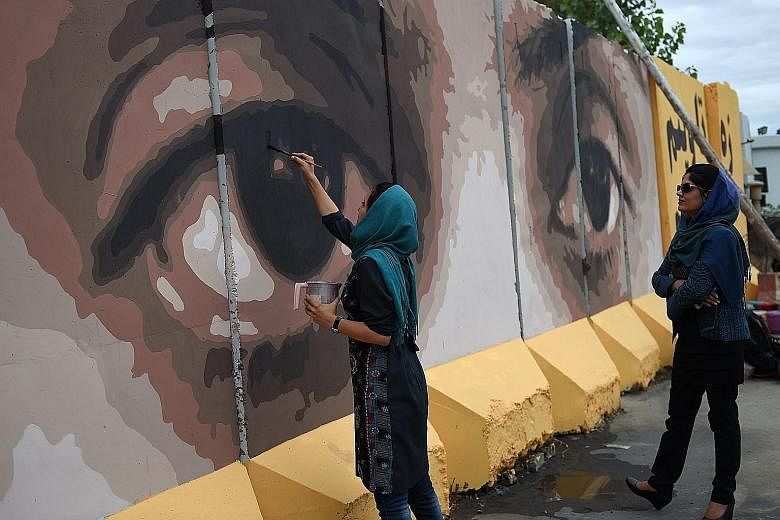KABUL • Under a soldier's watchful gaze, a group of artists paint a blast wall outside Kabul's presidential palace with a huge pair of eyes in bright, almost psychedelic colours.
Alongside the eyes, a slogan reads: "Corruption cannot be hidden from God or from the people."
The project is not some guerilla graffiti campaign but comes with the blessing of Afghan President Ashraf Ghani pushing an anti-corruption message.
One of the artists, 35-year-old Maryam, said the eyes were those of "all the Afghans who have had enough of corruption", gazing down on officials who might be tempted to take a backhander.
As the Taleban's insurgency has raged on, grey cement blast walls have mushroomed in Kabul in recent years, usually to insulate the rich and powerful.
That has prompted anger from Mr Kabir Mokamel, one of the other artists who created the fresco.
"They're supposed to protect us? No, I think they're supposed to protect the people who are inside. And me, I am outside the wall," he said.
The anti-corruption message, written in the two main Afghan languages of Dari and Pashto, resonates deeply in a country where the culture of graft is entrenched at every level of life and especially among public officials.
Fourteen years after the fall of the Taleban, Afghanistan remains stuck in the depths of Transparency International's annual corruption perception rankings, lying 172nd out of 175 countries.
Feeding the longstanding culture of graft is the lack of proper checks on the billions of dollars in foreign aid that have poured in since 2001.
The US Inspector-General for Afghan Reconstruction, Mr John Sopko, gave a blunt assessment in a speech last year, saying: "If corruption is allowed to continue unabated, it will likely jeopardise every gain we've made so far in Afghanistan."
Mr Sopko's remarks came as Mr Hamid Karzai, whose presidency was dogged by suspicions of large-scale corruption, handed power over to Mr Ghani after a bitterly disputed election.
Mr Ghani, a former World Bank economist, has made eradicating corruption one of his top priorities, but the challenge is enormous, said a government employee working on the graffiti project.
"Petty corruption is visible in every small office you visit," the official said. "We are attracting the attention of people, we are doing something through art. It's a different method to fight corruption."
Mr Mokamel has already painted the large accusing eyes on the wall of the National Directorate of Security, Afghanistan's main spy agency, and plans to decorate the wall around the presidential palace complex and central bank.
"I have been trying to do this project for the last three years," he said. "But now there are many young people inside the new government and they understand the value."
In a militarised, concrete capital regularly hit by bloody attacks, street art is a rare sight. Aside from the political and artistic aspects of the project, Mr Mokamel sees an immediate benefit for all Kabulis.
"These blast walls - they're really ugly. Our idea was to put something on them so that they would disappear," he said.
AGENCE FRANCE-PRESSE

